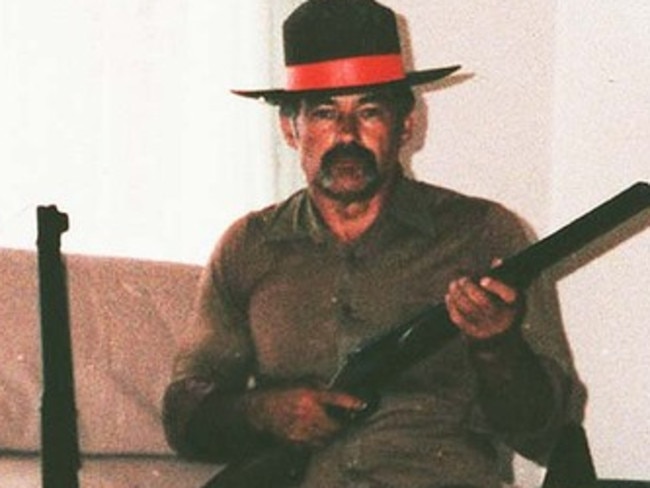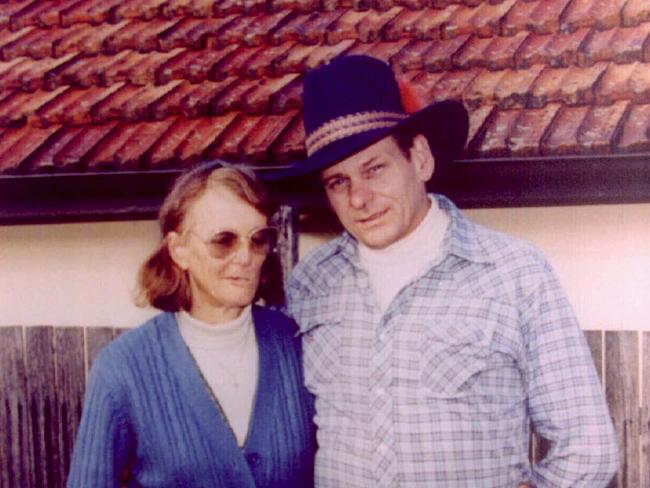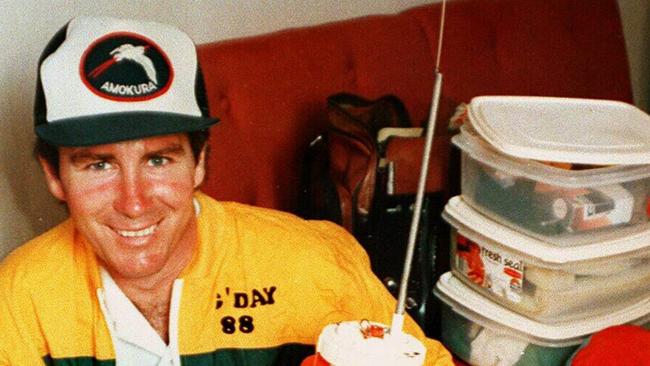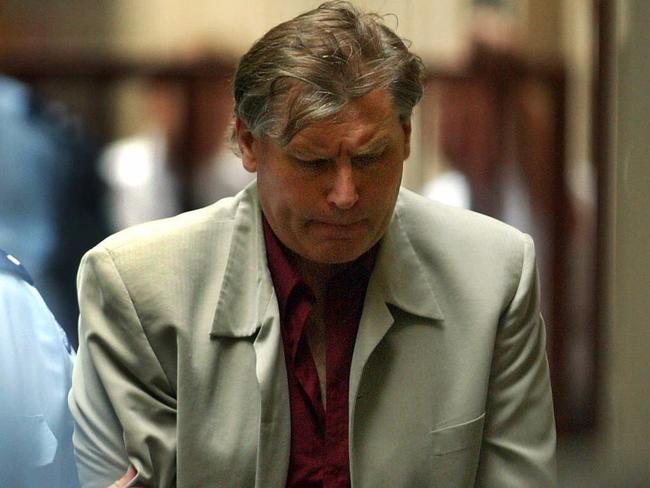A trail of bodies wherever they went
THE NSW Homicide Squad has announced the start of a new push to find answers to some of the 600 unsolved killings in NSW, writes Janet Fife-Yeomans
NSW
Don't miss out on the headlines from NSW. Followed categories will be added to My News.
TWO metres tall, powerfully built and calling himself Tex, Reginald Kenneth Arthurell appeared as a typical outback drifter to the police officers with whom he was enjoying a beer and a barbecue.
They even posed together in a photograph that day at Avon Downs Police Station in the dry Northern Territory summer of 1981.
The cops had no idea that the stetson-wearing cowboy who regaled them with tales of his days on the rodeo circuit was a serial killer. He was hiding right out in the open.
On the run for at least two murders and possibly four more, Arthurell had even deliberately sought a job at a pub which was patronised by local detectives investigating one of the killings.
Serial killers are masters
of appearing normal. Chameleons and confidence tricksters who can blend into any company, slip in and out of any neighbourhood. It is only when they are caught and their evil secrets exposed that the public sees a killer where the week before they saw just an ordinary bloke.
There are at least 600 unsolved killings in NSW alone, not counting scores
of missing persons that are probably also murders. Thousands of families across Australia wait every day for the answer to why their loved one never came home.
Detectives with the NSW unsolved homicide squad announced this week that they are cross-referencing the movements of notorious serial killers and known predators with unsolved murders and missing persons cases in an extraordinary cold-case review that stretches across state and territory murders. Among them are Arthurell, Ivan Milat, Ashley Coulston and Bandali Debs.
The police are wary of getting up the hopes of any of those families waiting for answers and will not publicly confirm the names of any potential victims.
Between them, Arthurell, Milat, Coulston and Debs are known to be responsible for 17 killings but detectives believe that wherever they went, they left behind a trail of bodies and missing people.

The most infamous of them all is Milat, 70, so far the country’s worst known serial killer.
He was jailed for life in 1996 for the murders of seven backpackers whose bodies were found in the Belanglo State Forest.
They had been dealt with as unconnected missing persons cases — the first of them, Victorian couple Deborah Everist and James Gibson, were reported missing in 1989.
Detectives who led the hunt for Milat later found 16 unsolved murders they matched to the style of the backpacker killings and compiled a list of 43 missing people.
Among them were Leanne Goodall, 20, Amanda Robinson, 14, and Robyn Hickie, 15, who all disappeared from the Newcastle area within four months of each other in late 1978 and early 1979.
At the same time, Milat was working on local roads and staying at places such as the Orana Hotel, the Star Hotel, the Gunyah Hotel, the Golden Eagle Motel and the Pelican Palms Inn. The 2002 inquest into the girls’ disappearances heard that most of the hotels where Milat stayed while working for the Central Asphalt Depot were either on or close to the Pacific Highway or near the suburbs where three girls went missing.
In 1980 Milat was living with his mother at Guildford and working at what was then the Department of Main Roads at Rosehill. The depot was less than two kilometres from the Tollgate Hotel in Church Street, Parramatta, a hangout for DMR workers.
On July 12, 1980, flatmates Gillian Jamieson and Deborah Balkan, both 19, disappeared after leaving the hotel where they had been seen with a man wearing work clothes and a black cowboy-style hat.
In November 1987, Milat was working for the DMR in the Jenolan State Forest area, 160km west of Sydney and living with his mum in south-western Sydney when Peter Letcher, 18, was last seen alive. He had left Busby in south-western Sydney, intending to hitchhike home to Bathurst.
His body was later found stabbed and then shot, execution style, and his body covered with branches in the Jenolan State Forest. Former assistant commissioner,Clive Small, who led the taskforce into the backpacker killings, believes Letcher’s murder has all the marks of a Milat killing.

Reginald Arthurell
Avon Downs is about 250km northwest of Mt Isa where in October 1978 the decomposing bodies of three campers, Tim Thompson, 31, his girlfriend Karen Edwards, 31, and Gordon Twaddle, 21, were found in bushland.
All had been shot in the head at close range in a “Wolf Creek” style killing.
The trio had been last seen at the Mt Isa rodeo and witnesses told police they had been in the company of a man dressed like a cowboy. Police believe that Arthurell could have been at the same show.
Queensland Police publicly named him as a suspect. The murders remain unsolved.
While he followed the rodeo circuit and modelled himself on an American cowboy, Arthurell couldn’t ride. He had over 70 aliases including Hank, Buck and Neville and convictions for dishonesty, vagrancy and possessing an unlicensed pistol and had once tricked police by dressing as a woman.
In 1971, Coonamble was isolated by flood waters when Arthurell, then 25, was visiting a friend in the town. The friend lived just around the corner from Catherine
Mary Page, an 82-year-old churchgoing spinster who was found bludgeoned to death. Arthurell has been named as the main suspect in her unsolved murder.
When he left Coonamble, Arthurell drifted to the north of Western Australia, working in a hotel and hospital in Derby, a roadhouse at Fitzroy Crossing and isolated cattle stations. He made his way to Sydney to visit his mother in 1974 when he bumped into his stepfather, Thomas Thornton, 49, a council driver.
A warrant was issued for Arthurell’s arrest when Thornton was found dead, stabbed nine times in his home on Robertson Street, Granville on May 24.
Arthurell moved north, turning up at the Three Ways Roadhouse — on the intersection of the Stuart and Barkly Highways — late in the afternoon of November 2, 1981. It was the eve of the Melbourne Cup and the place was packed as a cup sweep was being run.
Among them was Ross Browning, 19, and the man he was giving a lift to in his brown Holden station wagon after meeting the day before, Neil Buckley. Browning had made the mistake of confiding in Buckley that he had $600 hidden under the driver’s seat. A chance meeting with Arthurell led to Buckley inviting him to join the drive.
About 14km down the Barkly Highway from the roadhouse, the two men bashed Browning and stole his money. Arthurell had Browning’s blood and hairs from his head stuck on the knee of his jeans from putting his knee on the sailor’s head.
It was while on the run that Arthurell took up with the police at Avon Downs. He was arrested on November 23 while working as a chef at the Corncob Hotel near Tolga, between Mareeba and Atherton on the Atherton Tablelands. Both Arthurell and Buckley pleaded guilty to manslaughter. Their claim that they had not meant to kill Browning was believed by the prosecutors.
Arthurell was jailed for 12 years with hard labour and released on parole on May 11, 1988, having served his six-and-a-half year minimum period.
He was extradited to NSW where he was allowed to plead guilty to the manslaughter of his stepfather. Arthurell managed to bluff the judge that he was “growing into a more caring, gentle and loving person”. It was noted that he had taken up Christianity and undergone a “remarkable transformation”.
In July 1989 he was jailed for seven years with a non-parole period of just under three years. Behind bars, his luck continued when he was visited by a Christian charity worker Venet Mulhall. Mulhall was lonely, divorced and a good, caring woman.
On April 1991, he was released on parole on condition that he live with Mulhall, to whom he was briefly engaged. On February 11, 1995, he bashed her to death with a piece of wood and stole her car. Six months later he was arrested in Queensland.
Back in NSW and convicted of murder, the Crown pushed for life. Instead, Arthurell got 24 years with a minimum term of 18. He can apply for parole from May 25 this year.

A series of rapes had terrified the Sutherland area in southern Sydney. The attacker wore a balaclava and carried a sawn-off shotgun.
One couple was grabbed on a bush track, hoods put over their heads and the man, 24, chained to a tree while the woman, 18, was raped.
The terrifying attacks in the mid-1980s were chillingly similar to a series of rapes in Tweed Heads and the Gold Coast a few years earlier. Again, the attacker wore a balaclava and carried a
sawn-off gun. He fled the scenes on his motorbike.
They had turned fatal in the early hours of February 2, 1980, when Jeffrey Parkinson, 33, and a female friend, 29, were abducted at gunpoint from the car park at the Twin Towns Services Club and ordered to drive to Cobaki Creek. The attacker wore a balaclava and carried a
sawn-off gun.
Parkinson was shot dead as he fought off the attacker to allow his friend to escape.
Linking the two sets of serial rapes was Ashley Coulston. He was living in the Tweed Heads area, where his parents had a farm, in 1979 and 1980. The rapes ended when he moved to Sydney.
Coulston, who had a black Kawasaki motorbike, lived on a boat at Cronulla, close to Sutherland. In 1986, he was sacked from his job after a female colleague claimed he had been stalking her.
Evidence indicated the Balaclava Rapist and the Sutherland Rapist shared the same blood type as Coulston.
He had a strange history — just 14, he broke into the home of two schoolteachers at their flat in Tangambalanga, in the Kiewa Valley in Victoria. Armed with a .22 rifle, he forced them to drive into NSW where they managed to escape at a truck stop.
In 1985, he had left a sawn-off .22 rifle in a car a couple had lent him.
Coulston was dubbed Captain Bathtub in 1988 when he sailed his 2.4m boat, G’day 88, across the Tasman Sea to
New Zealand.
On July 29, 1992, student teachers Kerryn Henstridge and Anne Smerdon, both 22, answered the door of their unit at Burwood, Melbourne, to a man who had answered a newspaper ad for a flatmate.
Both girls and family friend Peter Dempsey, 27, who was staying with them, were bound, gagged, moved to separate rooms and shot in the head. Coulston was finally caught on September 1 that year when he tried to abduct a couple in Melbourne. He was wearing a balaclava and carrying a sawn-off shotgun.
Coulston, 58, is in jail
for life.

Bandali Debs was seen as a suburban dad, a father-of-five, a hardworking tiler who was even “henpecked” by his wife as they lived in the the south-eastern Melbourne suburb of Narre Warren. One of his three daughters referred to him affectionately as “f...head”.
Last year, the then Victorian police commissioner Ken Lay revealed that Debs was a person of interest in a number of unsolved murders, describing him as one of the “most despicable human beings in Victoria”.
“We will continue to look at a whole host of issues around this man and I suspect work around him will continue for years to come,’’ Mr Lay said.
“There are murders going back years in this state which some of my people will look at and think, ‘This fits the Debs profile’.”
On April 21, 1995 as prostitute Donna Hicks, 35, a mother of three, was plying her trade along the Great Western Highway in Sydney, Debs was barely on the police radar. An assault, a suspended sentence for reckless conduct endangering serious injury, a driver’s licence which had been cancelled for a time.
He hadn’t been caught for 38 armed robberies across Melbourne during which a man was shot and left a paraplegic.
A hulking figure of a man, Debs had been visiting his German-born mother in Sydney. His sister lived near the Colyton Hotel, where Hicks had been drinking the previous night. He picked her up in his blue Holden Rodeo, had unprotected sex and shot her in the head. He left her body in a ditch and drove home to Melbourne.
Two years later, on the afternoon of June 17, 1997, Debs was driving along the Princes Highway near Dandenong when he saw Kristy Harty, 18, trying to drum up some business.
She was an 18-year heroin addict who had turned to prostitution, selling what she called “jiggy jig” for $50. Debs picked her up and drove to the track. They had unprotected sex and he shot her at point blank range with a .357 Magnum.
When her body was found, the bullet was too damaged to link it to any gun but a DNA sample was put on the police data base.
Born Edmund Plancis, Debs had left home early and was adopted by a man who ran a boarding house, taking the man’s name of Bandali Michael “Malik” Debs.
After the murder of Kristy, Debs returned to stick-ups with one of his daughter’s boyfriends. Debs had once tiled the Silky Emperor Restaurant in Moorabin and the two men were casing it out for a robbery when they were pulled over just after midnight on August 16, 1998, by two police officers. Sergeant Gary Silk and Senior Constable Rod Miller were shot dead.
Convicted of the murders of the two police officers, Debs’ DNA went into the police data base and up came the cold case hits on Harty and Hicks.
In jail for life, Debs, 61, has emerged as a suspect in the 1990 disappearance of Sarah MacDiarmid, who went missing from Kananook railway station, near Frankston, on July 11, 1990, as detectives believe that Harty and Hicks were not the first, or the last, of his victims.


